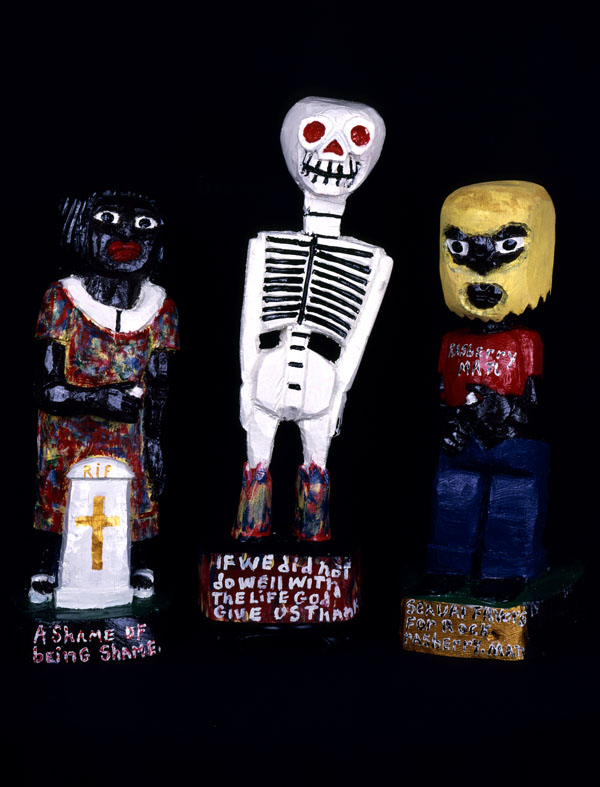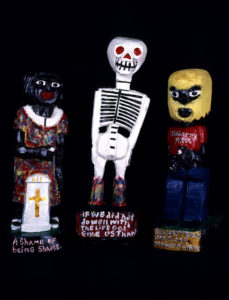Herbert Singleton
Self-taught artist Herbert Singleton created dramatic scenes of the rough New Orleans environment into which he was born, using found objects such as salvaged doors, driftwood, and discarded furniture.

Courtesy of Ogden Museum of Southern Art.
These figures, made in 1992 and 1998, are titled "Strawberry Woman," "Boyfriend," and "Raspberry Man."
Self-taught artist Herbert Singleton created dramatic scenes of the rough New Orleans environment into which he was born on salvaged doors, driftwood, and discarded furniture. Perhaps no other American wood-carver produced works that are as autobiographical and as illustrative of the corrosive character of African American inner-city life. Yet his brightly painted woodcarvings also depict biblical narratives and scenes of New Orleans’ African-American cultural traditions, suggesting the possibility of repentance and transcendence.
Born to Herbert, Sr., and Elizabeth Singleton on May 31, 1945, Singleton was the oldest of the couple’s eight children. When Singleton was around ten years old, his father, who worked for the New Orleans utilities department, left home one day to purchase a pack of cigarettes and never returned. His mother later found employment in a hospital. Singleton dropped out of school after the seventh grade and spent most of his time hanging out in the streets of Algiers on New Orleans’ West Bank. He associated with gangs, pimps, and prostitutes and experimented with illegal drugs, eventually spending thirteen years incarcerated in the Louisiana State Penitentiary at Angola for various narcotic-related offenses.
Singleton’s encounters with law enforcement officials have been frequent and traumatic. In 1980 one of his sisters and two of his male friends were shot to death in an early morning raid by three white police officers who were searching for suspects in the murder of another white police officer. The raid occurred in New Orleans’s predominantly African American community of Algiers. During the aftermath of the raid, Singleton and several other residents were taken to police headquarters, where they were allegedly beaten and tortured in attempts to obtain confessions. Singleton recalls that he and the other suspects were detained for over twelve hours and that a plastic bag was placed over his head in an attempt to suffocate him. Singleton has depicted this harrowing incident in one of his carvings, in which he is seen strapped to a chair with a white plastic bag over his head. In view of Singleton’s background, the numerous scenes of violence and police brutality depicted in his carvings are not surprising.
Singleton’s artistic impulses were evident during his boyhood. As a young child, he frequently walked along the banks of Mississippi River and amused himself by fashioning snakes from the muddy clay. Unhappy with the impermanence of his figures, Singleton decided to work in wood and initially picked up pieces of driftwood from the river when it was low.
Around 1975 Singleton began carving walking sticks from ax and pick handles. His clients were buggy drivers in the French Quarter, pimps, and drug dealers. In the 1980s, he began carving more ambitious three-dimensional sculptures and relief panels from logs, tree trunks and stumps, discarded doors, pieces of driftwood,, and panels from old wardrobes and other pieces of cast-off furniture. The fact that all of Singleton’s sculptures were carved from pieces of found wood—he never purchased precut panels—contributes to the powerful, emotive quality of his work. Singleton painted virtually all of his sculptures in bright colors.
Subject matter among Singleton’s carvings may be grouped into three categories: religious scenes, scenes from contemporary African-American street life, and social and political themes of national and international scope. Given the frequently violent incidents of his past, it is not surprising that many of Singleton’s most compelling sculptures recalled his own experiences. Death, police brutality and harassment, lynchings, tavern brawls, dishonest card games, prostitutes and pimps, and scenes of prison life abound. Singleton’s raw and emotive depictions of various aspects of the drug subculture are not always comfortable to view; they are unusually graphic since they were carved by a person who experienced many of these activities firsthand. Panels that depict various Mardi Gras activities and second-line parades, provide a more lighthearted dimension to Singleton’s work.
Singleton was a prolific artist and he estimated that he carved more than two hundred works. Most of his sculptures were relief panels, but he also carved a number of three-dimensional pieces. Some of his freestanding sculptures are large, standing seven feet high, and his largest doors are nine feet tall. He did not make preliminary drawings, preferring to sketch his designs directly on the wood. He carved primarily with a hammer and chisel and also pocket knives, and he generally did not incorporate negative areas in his panels. There are numerous inexplicable stylistic analogies between Singleton’s sculptures and those by wood-carvers of the Yoruba tribe in southwestern Nigeria, West Africa, with which Singleton was not familiar.
Due to their large scale, boldness, and frequently uncomfortable subject matter, Singleton’s sculptures were not widely collected at the outset of his career;. however, by the 1990s, his works, especially the powerful carved doors, garnered widespread public acclaim. Singleton died of lung cancer on July 25, 2007 at age 62.
Singleton’s works are held by the Ogden Museum of Southern Art in New Orleans, the New Orleans Museum of Art, Smithsonian American Art Museum in Washington, D.C., the American Visionary Art Museum in Baltimore, Maryland, the Collection de l’Art Brut in Lausanne, Switzerland, the High Museum of Art in Atlanta,Georgia, and major private folk art collections.
Adapted with permission from Pictured in My Mind : Contemporary American Self-Taught Art from the Collection of Dr. Kurt Gitter and Alice Rae Yelen, University Press of Mississippi
